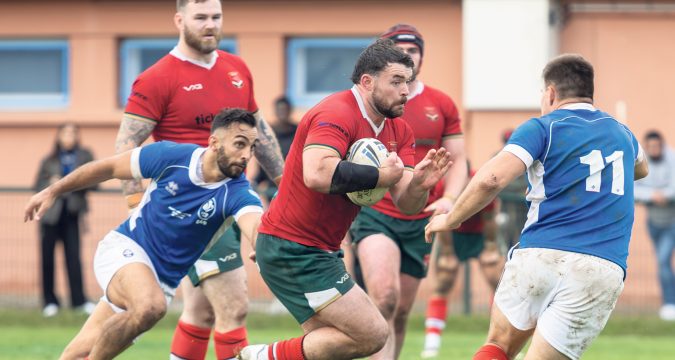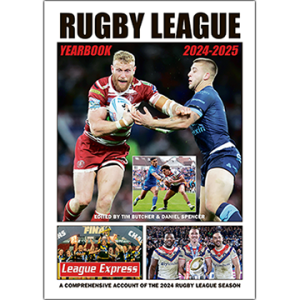
International rugby league is all too often a rare experience, so it has been positive for France to be able to welcome Wales, Serbia and Ukraine for the European Challenge tournament.
FOR MANY of my compatriots here’s what an autumn of sports looks like.
News is dominated by football, with the domestic first division championship recommencing. A championship where matches are rarely sold out although we wouldn’t say no to their crowds! A championship where you have to choose between two hyped clubs: Paris St-Germain or Olympique de Marseille. To watch the games, you need to pay. But to follow the championship, you just have to keep your eyes or ears wide open. It’s all over the media, you can’t escape it. Football fans can also access the games of the national teams (women’s ones as well) via free-to-air channels.
In the south, especially in the south-west, it’s also rugby union time, with the Top 14 and the autumn series, (a strange concept for rugby league fans: nations from both hemispheres playing other nations). If you want to watch the whole event, you have to pay, but then again, the games of the French national sides will be available on free-to-air channels. The stadia will be filled as well. Finding people ready to pay to watch union in this country has never been too difficult and union is not afraid to take risks either, organising a game between New-Zealand and Georgia in Montpellier.
Our rugby à XIII’s autumn is dominated by the relaunch of the domestic championships, the end of the NRL and Super League. Also this season, a surprise on our screens; the women’s game Déesses Catalanes v Lescure-Arthès (area of Albi) was televised on Vià Occitanie, and it was a very pleasant game to watch with a convincing victory of the visiting team against the current champions (16-22).
But usually, there are no test-matches. No confrontation between nations.
France is definitively not southern hemisphere; even if we Treizistes are aware of the international matches played in Oceania, and know where to watch them, they are rarely covered in the mainstream media. And this has immediate consequences: The French public would never associate Fiji (or Tonga or even Samoa) with anything else than sevens and union. Or Papua New Guinea even with rugby (either code). Kiwis are almost unknown and the Kangaroos’ image is skilfully blurred with confusion surrounding another major sport in Australia; AFL. England, sorry about this, is only associated with the red rose of the union team and French mainstream media ignore the north of England except to cover football.
Therefore, the organisation of a rugby league ‘European Challenge’ in the south of France recently was more than welcome. On paper, an interesting tournament with France and Wales, two serious contenders for World Cup qualifications, but also with Ukraine and Serbia. Ukraine, a country at war, what an incredible story to tell! Serbia may not be at war, but could have had many excuses for not playing rugby league. Yet, both Slavic teams were here. Resilience is an overused word, yet it could fit the situation of these two nations, which have not only a genuine national team, but also have domestic championships.
Both games of the Ukrainians – the first against France in Carcassonne (lost 8-74), the second against Serbia (lost 10-50) at Saint-Estève – did get attention; Midi Olympique, the union magazine even put them on their cover! Some of their players are also soldiers in the ongoing war and explained how they felt about sport providing an interlude from the fighting. Despite their two heavy defeats, they were constantly cheered by groups of Ukrainian refugees living in France who came to the stadia.
There were, inevitably in rugby league, some discordant voices about the standard of the teams, that could be summed up by one sentence heard on the Carcassonne XIII YouTube channel: “Ukraine? I didn’t even know they had a federation!”.
It’s true to say this competition was no match for France who beat their opponents easily (74-8 against Ukraine, 46-6 against Wales), earning the so-called ‘privilege’ to go on and play the next stage where the Chanticleers will join emerging nations to qualify for the next Oceanian, ahem…sorry, the next World Cup in 2026.
No such privilege for Wales, another historical rugby league nation, even if Georges Aillières, the famous French international player who passed away in October at the age of 89, wouldn’t have recognised a team he played thrice, beating them twice with a very tight score. But Wales lacks, like France, a regular international calendar of fixtures.
Cynically, I suspect that the Australian organisers will be hoping that Cook Islands will make it and qualify for the World Cup; the tickets would be easier to sell for them I presume in that case, and the commercial space easier to sell for the Oceanian market.
Would they prefer Jamaica to France? That’s a good question to ask them! Even if some Australians are well aware of French rugby league’s international history, it doesn’t count in the NRL influenced ‘reset’ of world rugby league. But a World Cup with only one European team participating would be a regression for our sport.
France will probably be the second European nation qualified along with England, but is now a on tricky path; Cook Islands and Jamaica, if they are not regarded as serious contenders by the French players, could be more difficult to play than expected.
Could the game against South Africa also be a risk, in terms of suffering injuries to key players, which are always a possibility in any game of RL?
Laurent Frayssinous will also have to deal with a variable pool of players being available, competing with the requirements of their domestic clubs. It won’t be easy for the French Federation to mediate with the various stakeholders.
However, the most important thing is that this autumn, we’re feeling something in the air, an international atmosphere!
But it’s up to the European and the International Federations to make sure that this atmosphere becomes more solid and coherent in the years ahead, and not merely a vague fragrance.
First published in Rugby League World magazine, Issue 503 (December 2024)
Click here to subscribe to the print edition of Rugby League World




